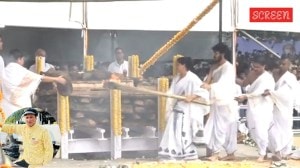Build bridges across the Gulf
Foreign Minister Jaswant Singh's successful visit to Saudi Arabia is an important new building-block in the architecture of Indian foreign...

Foreign Minister Jaswant Singh’s successful visit to Saudi Arabia is an important new building-block in the architecture of Indian foreign policy which, along with a series of such other initiatives, must dispel the impression that there is excessive focus on the Indo-Pak axis. That such an impression persists is possibly a failure on the media front to generate debate and discussion, educate the people, on the striking new initiatives. The absence of popular involvement, at nodal points across the nation, on the new masonry in foreign affairs leaves a vacuum, which is then filled up by Indo-Pak (Kashmir) stories as part of the country’s internal agenda.
The world has moved at a frenetic pace in the past 25 years. Remember Belinguer’s ascent to power in Italy; Marchais knocking at the gates in France; post Franco and Salazar leftward lurch in Spain and Portugal; Angola and Mozambique slipping into Marxist hands. Mengestu in Ethiopia, Ortega in Nicaragua.
A popular comedian in Washington had an amusing image to describe detente: “It is like going to a wife swapping party and returning home alone.” Patrick Moynihan was describing the UN as a “very dangerous place”.
Came the Reagan counter-offensive putting military pressure on Mengistu, Ortega, Dos Santos and elsewhere. Hand in hand with Margaret Thatcher, Reagan’s counter-offensive, in a cumulative sort of way, resulted in the fall of the Berlin Wall.
The hollowness of the Soviet system stunned Moscow’s tentative allies. Let us not forget, the Indian foreign office was totally divided — a strong element sided with the coup in Moscow in August 1991. Then it was all over.
The Gulf War was the first physical manifestation of the new world order being boldly sketched. It was in preparation for the Gulf War that Saudi Arabia was brought under the American security umbrella — which is where it remains but is loosening itself somewhat.
The 70s had been turbulent for the Kingdom: Soviet occupation of Afghanistan (the fear was Soviet search for the warm waters of the Gulf), the attack on Haram al Sharief, turbulence of the Iran-Iraq war, the Iranian challenge to the Kingdom’s supremacy as leader of the Muslim world.
It was in these circumstances that Riyadh laid out the red carpet for Indira Gandhi in 1982. The two countries talked of a strategic partnership. There was no follow-up action. This is precisely the period when the Saudis were financing the Afghan war “by all means”, including the support of unbridled Islamic extremists in which the ISI played a major role with American endorsement.
Indian foreign policy was going through one of its swings. Kissinger’s Pentagonal design of global security (US, Moscow, Beijing, Japan and western Europe) left India out. Pakistan’s role in facilitating Kissinger’s secret visit to China enhanced that country’s culpability with Washington.
The Janata government under Morarji Desai’s premiership saw a change in the American perception. President Jimmy Carter came to New Delhi with a sketch of “global influentials”, of which India was one. The Shah in Iran, Daud in Afghanistan, Zia-ul-Haq in Pakistan, Morarji in India, Jayawardene in Colombo — all westward inclined. If all these regimes could be knit together in a series of interdependencies, the region would have been secured for good in the context of the Cold War.
Came the Saur revolution in Afghanistan, the Shah’s fall, the return of Indira Gandhi in 1980 — the “regional influential” thesis was in a mess. In a reversal of the Janata policies, Indira Gandhi actually welcomed the Soviets in Afghanistan.
With Prime Minister Vajpayee and Jaswant Singh at the helm, New Delhi has, with uncommon energy, embarked on a project of knitting together new sets of relationships globally and comprehensively. During the Riyadh visit, New Delhi’s considerable credit with Israel, for instance, mattered. Riyadh sees New Delhi as a player with a stake not just in Gulf stability but in the Middle East, including the peace process.
Riyadh paid up its Gulf War dues in 1998. It feels free to strike out on its own. Islamic extremism, protests by Sunni Wahabi extremists, bomb blasts in Riyadh and Dammam in the mid-90s, are pressing the country towards a sort of non-alignment.
Who knows, the Jaswant Singh visit may by closing an ancient circle. Only a strip of water divides our west coast from the Arabian peninsula. Relations predate Islam by millennia. One legend has it that the wood used in Kaaba was teak from Kerala. Also, do not forget that the Cheruman Perumal mosque was built in Cranganore near Cochin while the Prophet of Islam was still alive.
Riyadh paid up its Gulf War dues in 1998. It feels free to strike out on its own.
Photos



- 01
- 02
- 03
- 04
- 05




























